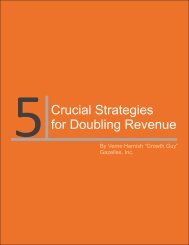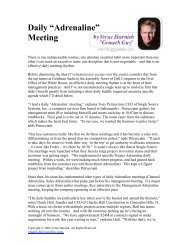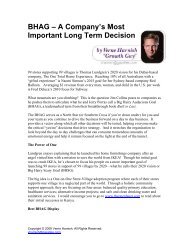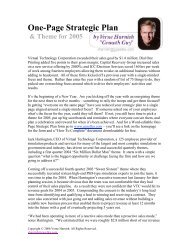THE POWER OF A MONTHLY MEETING - Gazelles
THE POWER OF A MONTHLY MEETING - Gazelles
THE POWER OF A MONTHLY MEETING - Gazelles
Create successful ePaper yourself
Turn your PDF publications into a flip-book with our unique Google optimized e-Paper software.
ALIGNING MIDDLE MANAGEMENT:<br />
<strong>THE</strong> <strong>POWER</strong> <strong>OF</strong> A<br />
<strong>MONTHLY</strong> <strong>MEETING</strong><br />
by Verne Harnish “Growth Guy“<br />
www.gazelles.com
<strong>THE</strong> <strong>POWER</strong> <strong>OF</strong> A <strong>MONTHLY</strong> <strong>MEETING</strong><br />
www.gazelles.com<br />
ALIGNING MIDDLE MANAGEMENT:<br />
<strong>THE</strong> <strong>POWER</strong> <strong>OF</strong> A<br />
<strong>MONTHLY</strong> <strong>MEETING</strong><br />
“We are one of the fastest growing franchises among 39 countries,”<br />
notes Niiraj Shah, National Director of BNI-India. “And yes, our<br />
3 hour monthly management meeting involving my four senior<br />
managers and nine Regional Directors, our middle managers, has<br />
allowed us to be more strategic and work on the business rather<br />
than in the business.”<br />
... you start to experience<br />
your own “Ground Hog<br />
Day” movie moments,<br />
where it feels like you’re<br />
reliving the same frustrating<br />
day, day in and<br />
day out.<br />
The toughest management challenge, as the leader of a growing<br />
business, is getting your DNA passed down to the next generation<br />
of leaders – those middle managers that either make your life easier<br />
by carrying a large management load of the business or wreak<br />
havoc as they repeat many of the same mistakes you thought were<br />
already resolved earlier in the company’s history.<br />
GROUND HOG DAY EXPERIENCE<br />
Once you get over 40 employees and you start to fill out a middle<br />
management level in the company, you start to experience your<br />
own “Ground Hog Day” movie moments, where it feels like<br />
you’re reliving the same frustrating day, day in and day out.<br />
The only viable solution I’ve found for developing an outstanding<br />
middle management and supervisory team is pulling them ALL<br />
together (yes that might mean spending some travel dollars) and<br />
spending four to eight hours each month collectively focused on<br />
the priorities and challenges of the business.<br />
Copyright © 2010 Verne Harnish. All Rights Reserved.<br />
vharnish@gazelles.com.<br />
1
<strong>THE</strong> <strong>POWER</strong> <strong>OF</strong> A <strong>MONTHLY</strong> <strong>MEETING</strong><br />
www.gazelles.com<br />
It’s in the process of wrestling common issues, challenges, and<br />
opportunities “to the ground” together that you, as the leader<br />
of your company, are able to share your industry knowledge,<br />
thought processes, approaches to problem solving, and core values.<br />
In addition, it provides you and your senior team real insight into<br />
“who’s getting and who’s not” among your middle managers, letting<br />
you know with whom you might need to spend a little more<br />
time training and coaching.<br />
It’s also a convenient time to provide some collective training and<br />
education. Schedule training on your new CRM system during<br />
this time or invite in a vendor to work with your team to share<br />
the latest developments in your industry.<br />
And as Jack Welch, former CEO of GE, experienced during his<br />
all day monthly visits to Crotonville, GE’s executive education<br />
facility, it was lecturing to and hanging out with the up-and-coming<br />
middle managers where he picked up the real stories behind<br />
the numbers he had been examining all month.<br />
AGENDA<br />
He expected everyone in<br />
management to give up<br />
one evening a month to<br />
work “on the business.”<br />
Gene Kirila, named the youngest hero of manufacturing in the<br />
U.S., is the one who turned me on to this key management meeting.<br />
In every one of the businesses he built, he would gather all<br />
his team leads, supervisors, middle managers, and senior leaders<br />
together and host them the third Thursday of each month at<br />
his lake cabin – just 30 minutes from his factories. He expected<br />
everyone in management to give up one evening a month to work<br />
“on the business.”<br />
Starting at 4pm he would gather his 12 to 15 middle and upper<br />
managers together and follow a strict 12 point agenda:<br />
Copyright © 2010 Verne Harnish. All Rights Reserved.<br />
vharnish@gazelles.com.<br />
2
<strong>THE</strong> <strong>POWER</strong> <strong>OF</strong> A <strong>MONTHLY</strong> <strong>MEETING</strong><br />
www.gazelles.com<br />
1. Growth Report- Good News and Actions Needed<br />
2. Drivers of Reputation and Productivity Report and<br />
Actions Needed<br />
3. Discipline Report on Priorities, Metrics. Meeting Rhythm<br />
4. Numbers- Performance Indicators, Financial Report and<br />
Actions Needed<br />
5. Market report on Customers Competitors News and<br />
Actions Needed<br />
6. Intellectual Capital/People Report and Actions Needed<br />
7. Corporate Calendar of events and Process reviews and<br />
Actions Needed<br />
8. Action Teams and Committee Report and Actions Needed<br />
9. Glossary of Terms updates<br />
10. Decision Time- People, Cash, Execution, Strategy<br />
11. Quarterly Action plan report and Actions Needed<br />
12. Review of the one page plan and consensus on edits<br />
then publish for sign off.<br />
... I have already seen the<br />
benefit of including mid<br />
and lower level managers<br />
despite my original reluctance<br />
to do so. It’s been<br />
a real awakening process<br />
for everyone.”<br />
Gene is now coaching other firms on how to run these monthly<br />
management meetings, including Keith Crownover’s team at Altoona,<br />
PA-based Delta Health Tech. Out of his 69 employees, he<br />
brings together his five senior managers, four mid-level managers,<br />
and four lower-level supervisors for a monthly meeting that uses<br />
Gene’s preferred agenda.<br />
Notes Crownover “we are relatively recent adopters of thesemonthly<br />
meetings…regardless, I have already seen the benefit of<br />
including mid and lower level managers despite my original reluctance<br />
to do so. It’s been a real awakening process for everyone.”<br />
For India-based Shah, his 3 hour monthly management meeting<br />
follows a simpler four part agenda:<br />
Copyright © 2010 Verne Harnish. All Rights Reserved.<br />
vharnish@gazelles.com.<br />
3
<strong>THE</strong> <strong>POWER</strong> <strong>OF</strong> A <strong>MONTHLY</strong> <strong>MEETING</strong><br />
www.gazelles.com<br />
1. Three – 5 minute education slots by 3 different directors.<br />
One covers a personal development tip, one covers how to manage<br />
more effectively and one covers how they can help their clients<br />
make more money out of their BNI membership.<br />
2. This is followed by an update from each director on his/her<br />
goals and achievements that they would like to trumpet and<br />
what the pipeline is looking like for the next 30-60 days. They<br />
look at 3 Key Result Areas (KRAs) – Number of members,<br />
number of visitors and amount of business generated. They<br />
also ask for help if required and other directors who would like<br />
to help with an issue take it offline.<br />
3. Announcements about key events and points to note from<br />
their HQ in the US.<br />
You can figure having<br />
7 % to 12 % of your total<br />
number of employees in<br />
these monthly meetings<br />
since this represents the<br />
typical range of “management<br />
span of control”<br />
within most organizations.<br />
4. This is followed by breakfast so that by 10.30am everybody<br />
is on their way.<br />
NUMBER <strong>OF</strong> PARTICIPANTS<br />
You can figure having 7 % to 12 % of your total number of employees<br />
in these monthly meetings since this represents the typical<br />
range of “management span of control” within most organizations.<br />
This means for a firm with 400 employees, I’ve seen 40<br />
to 50 supervisors to senior managers involved in these monthly<br />
meetings. This is actually and ideal number of participants if you<br />
want to maximize the diversity of ideas while keeping the meeting<br />
manageable.<br />
For Richmond, VA-based Rainbow Station, CEO Gail Johnson<br />
involves the Directors of her six corporate owned sites, two Vice<br />
Presidents, her CFO, Facilities Manager, and herself. With approximately<br />
175 employees in the core business, she knows it would<br />
also be ideal if she figured out how to include her franchisee partners<br />
as well. This would put her closer to the 10 % figure.<br />
Copyright © 2010 Verne Harnish. All Rights Reserved.<br />
vharnish@gazelles.com.<br />
4
<strong>THE</strong> <strong>POWER</strong> <strong>OF</strong> A <strong>MONTHLY</strong> <strong>MEETING</strong><br />
www.gazelles.com<br />
TANGIBLE RESULTS<br />
“...perhaps the most important<br />
is the fact that we<br />
have a chance to step off<br />
the intense daily merrygo-round<br />
of running the<br />
business to dedicate some<br />
very intentional time to<br />
forward looking strategic<br />
planning and the development<br />
of a shared vision.”<br />
For Larry Parrotte, COO of Springfield, VA-based TransForce,<br />
their monthly day-long management meeting has been in place<br />
for just over a year. Named the “Executive Leadership Series” it<br />
falls between their Quarterly Board Meetings and the Annual<br />
General Managers Conference. Tangible results include creating<br />
a strategy that has resulted in a new multi-year contract valued<br />
at over $ 2 million per year; naming two fundamental elements<br />
of their DNA and building into their branding and marketing<br />
efforts; and identifying the need to hold periodic focus group<br />
meetings with various field managers.<br />
Notes Parrotte, “While there are multiple tangible results and<br />
benefits we’re realizing from our monthly meeting series, perhaps<br />
the most important is the fact that we have a chance to step off<br />
the intense daily merry-go-round of running the business to<br />
dedicate some very intentional time to forward looking strategic<br />
planning and the development of a shared vision.”<br />
Copyright © 2010 Verne Harnish. All Rights Reserved.<br />
vharnish@gazelles.com.<br />
5

















